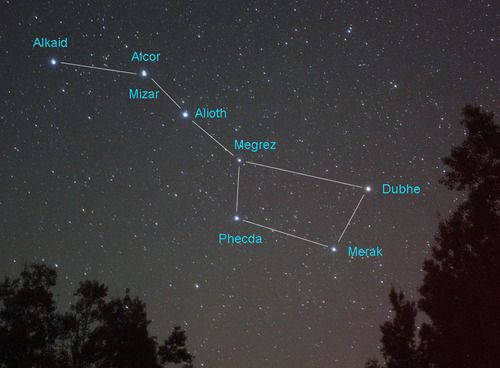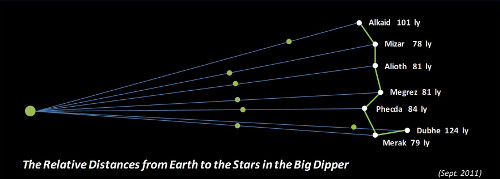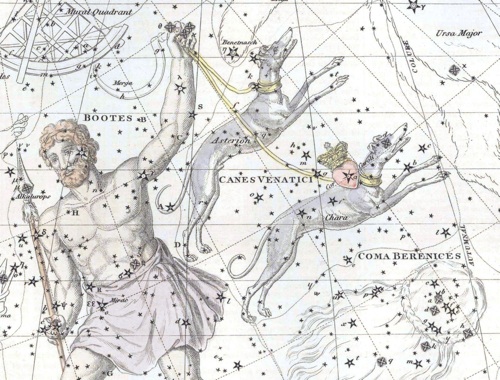By the way, who made up all these weird names? Well, the names for the pages on this website are my fault. But the names you'll see for stars and constellations on star maps come from the Greeks, the Romans, medieval Europeans, and Arabs.
Arabs? It's often a surprise to westerners, who see so much present-day barbarism in what's left of Islamic civilization, to learn that once such places as those now known as Afghanistan, Iraq, and Uzbekistan — to name just a few — were centers of culture and science, at the time when Europe was dominated by warlords and feuding theocratic states. This period of Eurpoean history is known as the Dark Ages, because they were so chaotic with barbarism that relatively little history of them has survived, and they are "dark" to us.
Great advances in astronomy were made during the European Dark Ages by men with names such as al-Khwarizmi, al-Farghani, al-Khujandi, and Omar Khayyam (who was also a poet, author of the famous Rubaiyat). European advances during the Late Middle Ages in medicine, astronomy, mathematics, architecture, music, literature – you name it – owe no small debt to Islamic civilization. Some of the Muslim knowledge in turn owed a debt to Greco-Roman civilization – all of which proves that the sun doesn't shine on the same dog's butt forever.
The constellations and the planets generally have Latin names. Some are just latinized Greek names. Some stars have Greek names or latinized Greek names. But a great number of the named stars have Arabic names, probably because it was easier for the medieval European astronomers to go with existing names than to bother to think up new ones. I'd have done the same thing. There's a system of using Greek letters to identify the stars the Muslim astronomers didn't name (and even the ones they did), but we'll worry about that later.
All the stars in the Big Dipper are named, and all of the names are Arabic (or European corruptions of Arabic names!). Meet the whole family.

Note that a lot of the Arabic names for stars begin with "al." This is the Arabic definite article, their equivalent of "the". Note the star on the end of the handle, named, Alkaid. This name means "the leader," and while it's thought to refer to the three daughters of the handle standing at the funeral bier, represented by the "bowl" of the dipper, it couldn't be more aptly named for the purpose it serves to naked astronomers. Alkaid will lead you away from the Big Dipper and across the night sky.
Before we go winging off into the night, let's have one more story from the Big Dipper.
Right next to Alkaid is a pair of stars called Mizar and Alcor. These were known to Arab astronomers as "horse and rider," which is a lot easier for us non-Arabic-speaking astronomers to remember. Once upon a time, Alcor was used as a self-administered eye test, before professional eye doctors with eye charts came along. If you could see Alcor as a separate star from Mizar, then your vision was considered normal.
However, the rider only appears to be on the horse. In reality, the two are not very near to each other. Mizar is 78 light-years away from us and Alcor is 83 – about 18 trillion miles apart! They look close together because they're in the same line of sight, the way a batter and an umpire, from some outfield camera angles, look closer together on TV than they really are. Here's a neat little chart that shows the relative distances of all of them, except Alcor:

Some people will tell you that Mizar and Alcor are "binary stars," but it ain't so. They're just "optical doubles" – a kind of "optical illusion." True binaries are stars which are actually much closer together and are orbiting around each other (technically, they're orbiting around a common point, but such details are more data than a naked astronomer needs to worry over). We'll run into some of these true binaries elsewhere, but not here.
So, before we shove off into the Sea of Night, how about a big hand for the Big Dipper, for showing us so many basic elements of astronomy?
OK, Johnny Olson, that's your cue: "Naked Astronomer, Arc on Doooowwwwnn!"
For much of the spring and summer, you can use the arc of the handle of the Big Dipper to "Arc on down to Arcturus." Arcturus is one of the brightest stars (the fourth brightest in the northern hemisphere), an orange giant about 25 times the size of the sun, and near the end of its career as a star. It's the first to appear in the still-blue sky at dusk in the late spring and early summer. After dark you can find it again by using the Big Dipper thus:

That kite-shaped constellation of which Arctutus is a part is called Bootes, which is pronounced “boh-AW-teez”. Bootes is one of the “oldest” constellations, in other words, one of the earliest to be recognized as such, some historians say it is the oldest. It was already well known when Homer mentioned it in the Odyssey more than 3,000 years ago. Bootes is variously depicted as a hunter and a herdsman, and has a relationship with the Big Dipper beyond Alkaid's finger-pointing.
The Dipper, remember, is a part of the Great Bear. Bootes may be either hunting the bear or driving it away from his flocks. The name, Arcturus, you see, is a latinized Greek word meaning "Bear Chaser" or "Bear Driver" (some say, "Guardian of the Bear"). The Greek word for bear is "arktos." The word "arctic" comes from this root, because the arktos, with its pointer stars, shows us the way to Polaris, which hovers over the arctic pole. Indeed, depending on how your imagination wants to flesh out the constellation, it looks like Bootes has one arm extended, which may be reaching out to grab the bear's tale or waving a club at it to chase it away, or holding the leashes of his dogs, the Canes Venatici, or Hunting Dogs. Or, maybe he just wants the Big Dipper so he can scoop out a drink of water. Arcturus is sometimes the buckle in his belt, sometimes the hem of his tunic, sometimes his knee.

Just to the left of Bootes is a bowl-shaped constellation called, the Northern Crown (Corona Borealis).

It's really more like a circlet that a prince would wear than a proper crown for a king. Maybe it slipped off Bootes' head when he went running after the bear. (Actually, legend says it belonged to Ariadne, whose husband, Dionysios, placed it in the sky in her memory. But how it ended up next to a wild and uncouth man like Bootes is another story.)
In any case, we're straying afield from the Big Dipper, which is exactly what we're supposed to be doing. No use crying over spilled crowns. Let Bootes come back and get it when he's done harrassing the bears, which won't be anytime soon, given his track record over the last several millennia.
We're off to meet the greatest hero in Greek mythology, who performed feats so daunting that his name became the basis of a modern word which means "the nearly impossible."
The Crown Points the way.